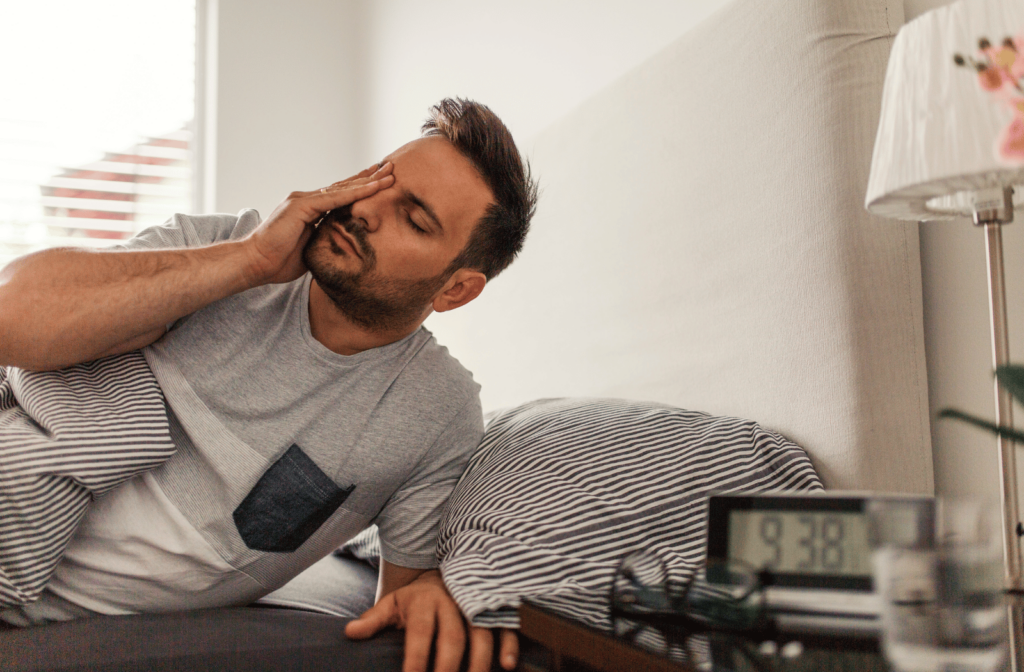Waking up with dry eyes is an uncomfortable way to start your day. Dry eye symptoms can cause eye fatigue immediately after you wake up, ruining a good night’s sleep and sometimes lasting throughout your day.
Dry eye can make it difficult to wear your contact lenses and disrupt your vision which can set your day up for a rocky beginning. Having dry eyes in the morning can result from low tear production, imbalanced tears production, or your eyelid position during your sleep cycle.
What Is Dry Eye?
Upwards of 16 million Americans contend with dry eye disease and the irritating discomfort that comes with it. Dry eyes affect your tear film’s three layers:
- The top layer of oil, produced by the meibomian glands, prevents tears from evaporating and helps the eyelid smoothly glide over the eye’s surface
- The middle layer of water and salt, produced by the lacrimal glands that wash away particles and moisturize your eye
- The innermost mucus layer, produced by the conjunctiva, helps the tear film cling to the eye and distribute tears evenly on its surface.
Each layer of the tear film is critical to keep your eyes hydrated and tear production at its best. Any problems in these layers can lead to dry eye disease.
Symptoms of Dry Eye
Some common symptoms of dry eye include:
- Eye redness
- Overwatering of the eyes
- Gritty sensation
- Difficulty wearing contact lenses
- Blurry vision
- Light sensitivity
- Stinging or burning sensation
If you’re waking up in the morning with any of these symptoms, it can indicate that you’re suffering from dry eye disease.
Nocturnal Lagophthalmos
Nocturnal lagophthalmos (NL) can cause dry eyes upon waking up. When you can’t close your eyelids entirely during sleep, it can impair the tear film’s functioning. It’s thought to be caused by facial nerve weakness or overstimulation of facial muscles.
Some people are born unable to close their eyes completely to sleep. Other causes include:
- Stroke
- Injury to the cerebellar artery, which delivers blood to the facial nerves
- Bell’s palsy
- Autoimmune disorders, such as Graves’ disease
Insufficient Tear Production
When your eyes struggle to produce enough tears, it may contribute to your morning dry eyes. Also referred to as aqueous tear deficiency, this type of dry eye occurs when your lacrimal gland, in the corner of your eye, has difficulty producing enough tears. The lacrimal gland is responsible for making the watery middle layer of the tear film.
When the middle layer of water and salt is insufficient, your tears can’t clear away debris or particles from the eye, causing a gritty sensation when blinking. This type of dry eye is related to aging or autoimmune conditions such as Sjogren’s syndrome, lupus, and rheumatoid arthritis. These conditions can damage the lacrimal gland.
Hormone changes, such as menopause, can be a risk factor for this form of dry eye disease.
Your optometrist can help establish the severity of your aqueous dry eye with a tear osmolarity test.
Poor Tear Quality
Dry can result from an imbalance in your tear mixture, affecting your tear quality. When the outermost layer of the tear film lacks oil, your tears can evaporate faster than they should. Commonly referred to as evaporative dry eye, this type typically results from a blocked or dysfunctional meibomian gland that can’t produce enough oil to stabilize the balance of the tear mixture.
When the meibomian gland is blocked or damaged from debris, computer and screen use, or makeup buildup, you may experience dry eye symptoms. Dysfunction in the meibomian gland is one of the leading causes of dry eye.
Treatment for Dry Eyes
Our clinic can help successfully diagnose and measure the severity of your dry eye disease and develop an individualized treatment plan with the most modern technology available. Following a comprehensive eye exam, we can identify the most irritating symptoms, their severity, and the root cause of your dry eye disease.
Equinox LLLT
For evaporative dry eye, low-level light treatment (LLLT) uses a wearable device to gently warm the meibomian gland and gently break down oil blockages.
LipiFlow
LipiFlow therapy uses a device that covers your eyelids and gently loosens blockages with heat while massaging debris from your eyelids.
Lumenis OptiLight IPL
Lumenis OptiLight IPL is the only FDA-approved intense pulsed light (IPL) treatment. Non-invasive, carefully calibrated light energy pulses will help melt hardened oils that may obstruct your meibomian glands.
NuEra Radiofrequency Treatment
To restore the natural balance of oils in your tear film, NeEra radiofrequency treatment penetrates the tissue of the eyelids to help rebalance lubrication in the eye and reduce inflammation.
BlepharoExfoliation
BlepharoExfoliation cleans away dirt, bacteria, particles, and blockages from the margins of your eyelids to manage dry eye symptoms.
Other Treatments
Your optometrist can also offer alternative treatments to help alleviate dry eye symptoms in the comfort of your home.
- Omega-3 supplements or foods such as salmon, halibut, nuts, and seeds can reduce dry eye symptoms and help prevent future symptoms.
- A warm compress on your eyelids can help break up oil blockages and soothe irritation.
- Prescription artificial tears temporarily manage symptoms.
Let Us Help with Your Dry Eye Symptoms
Higgins Brothers’ Vision Care has a wide range of treatments that can help address the causes of dry eyes rather than just the symptoms. After all, we are home to The Dry Eye Treatment Center of Connecticut!
For a comprehensive eye exam, dry eye treatment, and new prescription glasses or contact lenses, book an appointment with our experienced team to fulfill all your eye care needs.




